MITSUBISHI SPYDER 1990 Service Repair Manual
Manufacturer: MITSUBISHI, Model Year: 1990, Model line: SPYDER, Model: MITSUBISHI SPYDER 1990Pages: 2103, PDF Size: 68.98 MB
Page 531 of 2103
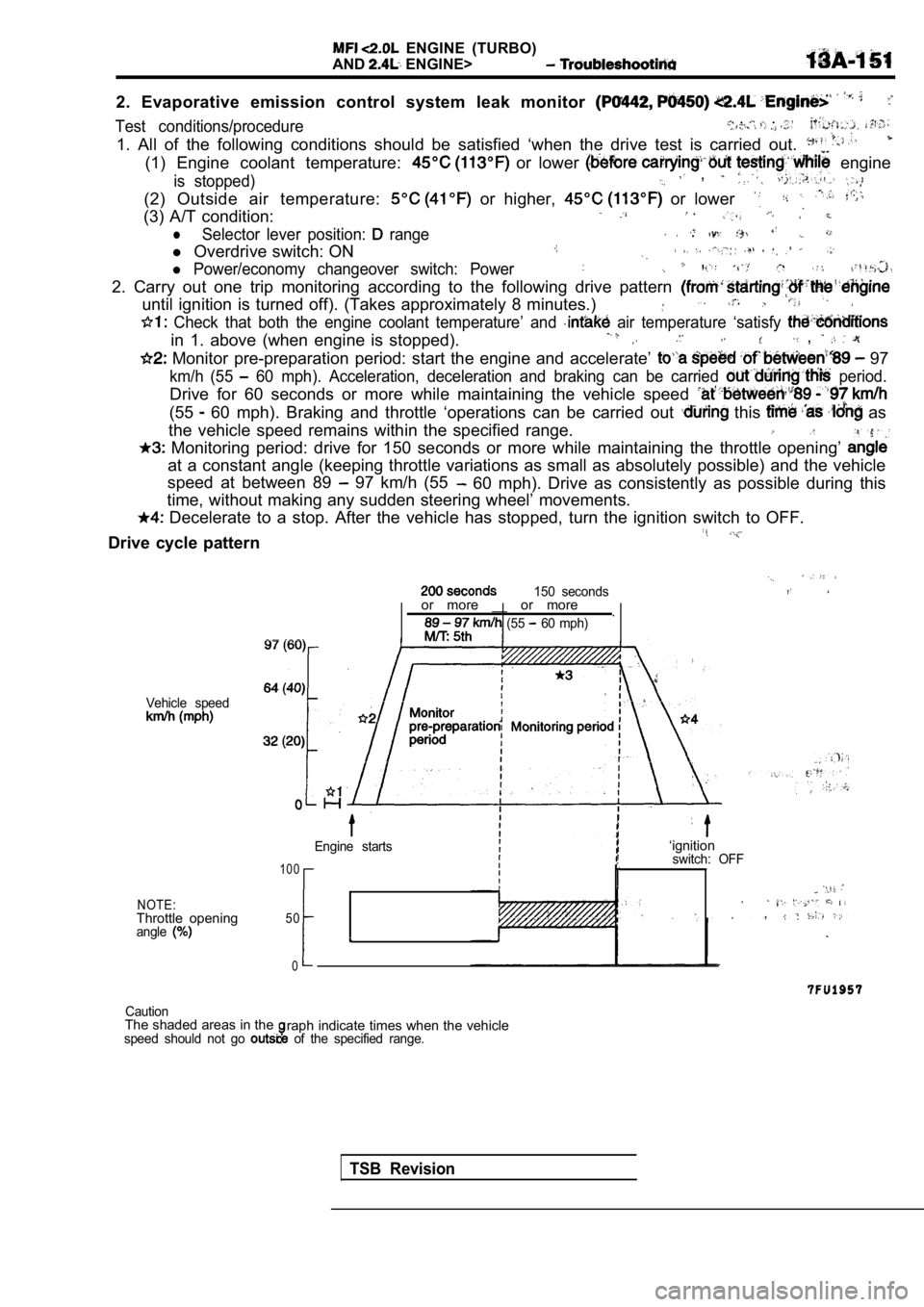
ENGINE (TURBO)
AND
ENGINE>
2. Evaporative emission control system leak monitor
Test conditions/procedure , . .
1. All of the following conditions should be satisfied ‘when the drive test is carried out.
(1) Engine coolant temperature: or lower engine
is stopped) ,
(2) Outside air temperature: or higher, or lower
(3) A/T condition: .
lSelector lever position: range .
l Overdrive switch: ON
l Power/economy changeover switch: Power
2. Carry out one trip monitoring according to the f ollowing drive pattern
until ignition is turned off). (Takes approximately 8 minutes.)
Check that both the engine coolant temperature’ an d air temperature ‘satisfy
in 1. above (when engine is stopped). ,
Monitor pre-preparation period: start the engine and accelerate’ 97
km/h (55 60 mph). Acceleration, deceleration and braking ca n be carried period.
Drive for 60 seconds or more while maintaining the vehicle speed
(55 60 mph). Braking and throttle ‘operations can be carried out this as
the vehicle speed remains within the specified rang e.
Monitoring period: drive for 150 seconds or more w hile maintaining the throttle opening’
at a constant angle (keeping throttle variations as small as absolutely possible) and the vehicle
speed at between 89
97 km/h (55 60 mph). Drive as consistently as possible during this
time, without making any sudden steering wheel’ mov ements.
Decelerate to a stop. After the vehicle has stopped, turn the ignition switch to OFF.
Drive cycle pattern
150 seconds
Vehicle speed
NOTE:Throttle openingangle
or more __ or more
.
(55 60 mph)
Engine starts
1 0 0
50
0
I
‘ignitionswitch: OFF
,
CautionThe shaded areas in theraph indicate times when the vehiclespeed should not go of the specified range.
TSB Revision
Page 532 of 2103
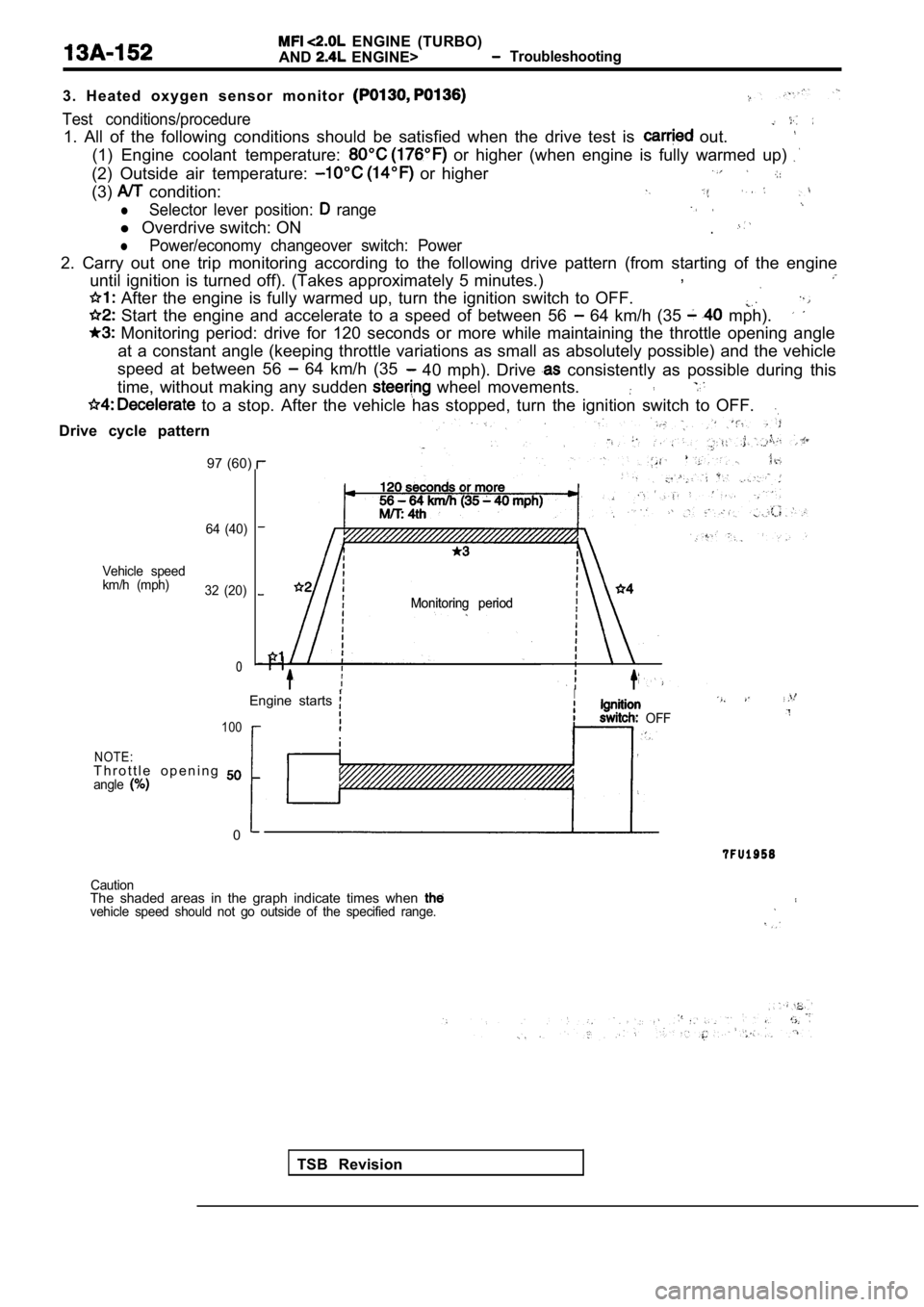
ENGINE (TURBO)
AND
ENGINE> Troubleshooting
3 . H e a t e d o x y g e n s e n s o r m o n i t o r
Test conditions/procedure
1. All of the following conditions should be satisf ied when the drive test is out.
(1) Engine coolant temperature: or higher (when engine is fully warmed up)
(2) Outside air temperature: or higher
(3) condition:
lSelector lever position: range
l Overdrive switch: ON.
lPower/economy changeover switch: Power
2. Carry out one trip monitoring according to the f ollowing drive pattern (from starting of the engine
until ignition is turned off). (Takes approximately 5 minutes.),
After the engine is fully warmed up, turn the igni
tion switch to OFF.
Start the engine and accelerate to a speed of betw een 56 64 km/h (35 mph).
Monitoring period: drive for 120 seconds or more w hile maintaining the throttle opening angle
at a constant angle (keeping throttle variations as small as absolutely possible) and the vehicle
speed at between 56
64 km/h (35 40 mph). Drive consistently as possible during this
time, without making any sudden
wheel movements.
to a stop. After the vehicle has stopped, turn the ignition switch to OFF.
Drive cycle pattern
97 (60)
64 (40)
Vehicle speed
km/h (mph) 32 (20)
0
Monitoring period
Monitoring period
TSB Revision
Engine starts
I. .
OFF100
NOTE:T h r o t t l e o p e n i n g angle
0
CautionThe shaded areas in the graph indicate times when vehicle speed should not go outside of the specifie
d range.
Page 533 of 2103
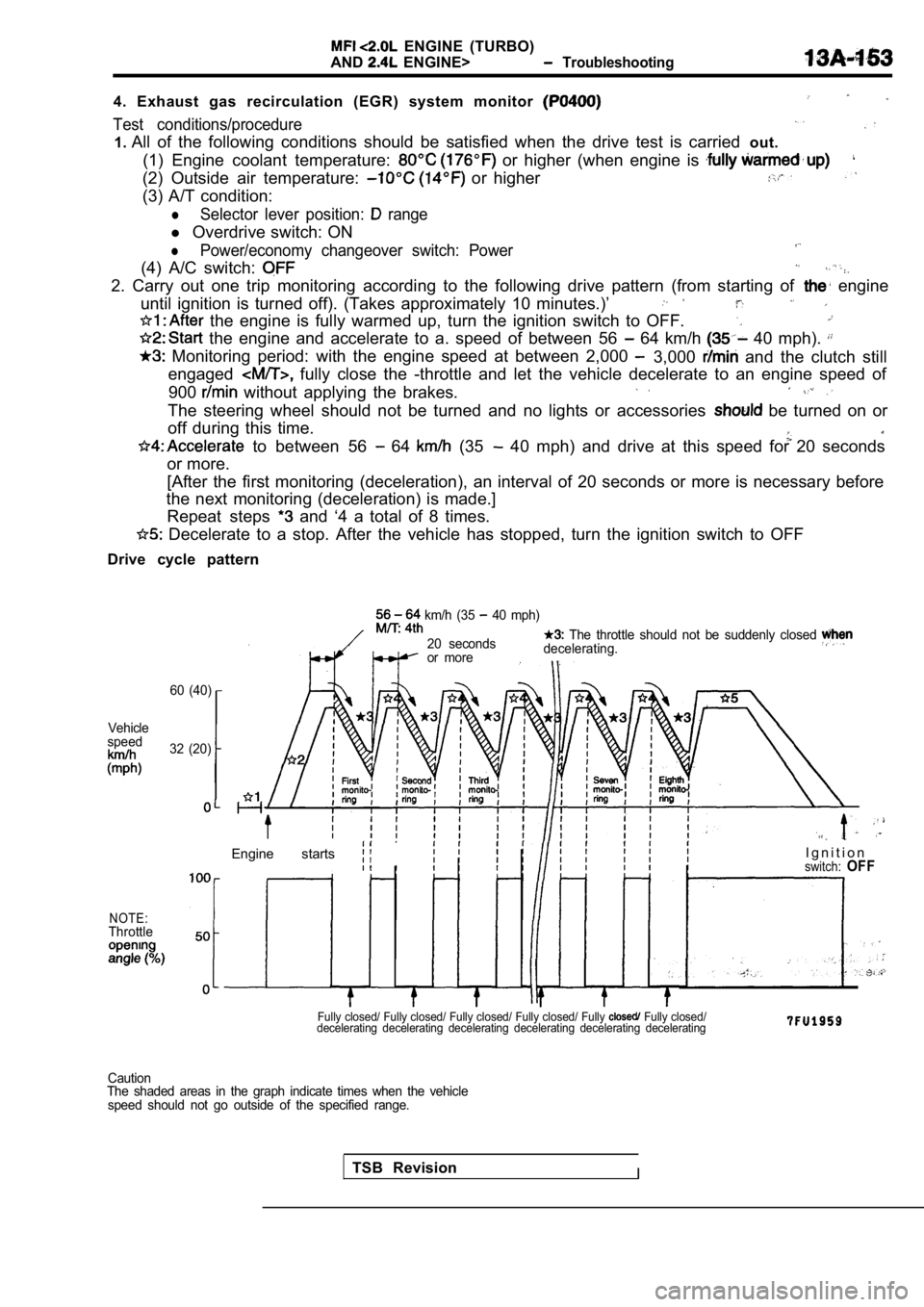
ENGINE (TURBO)
AND
ENGINE> Troubleshooting
4. Exhaust gas recirculation (EGR) system monitor
Test conditions/procedure
1. All of the following conditions should be satisfied when the drive test is carried out.
(1) Engine coolant temperature:
or higher (when engine is
(2) Outside air temperature: or higher
(3) A/T condition:
lSelector lever position: range
l Overdrive switch: ON
lPower/economy changeover switch: Power
(4) A/C switch:
2. Carry out one trip monitoring according to the f ollowing drive pattern (from starting of engine
until ignition is turned off). (Takes approximately 10 minutes.)’
the engine is fully warmed up, turn the ignition s witch to OFF.
the engine and accelerate to a. speed of between 5 6 64 km/h 40 mph).
Monitoring period: with the engine speed at between 2,000 3,000 and the clutch still
engaged
fully close the -throttle and let the vehicle dece lerate to an engine speed of
900
without applying the brakes.
The steering wheel should not be turned and no ligh ts or accessories be turned on or
off during this time.
to between 56 64 (35 40 mph) and drive at this speed for 20 seconds
or more.
[After the first monitoring (deceleration), an inte rval of 20 seconds or more is necessary before
the next monitoring (deceleration) is made.]
Repeat steps
and ‘4 a total of 8 times.
Decelerate to a stop. After the vehicle has stoppe d, turn the ignition switch to OFF
Drive cycle pattern
60 (40)
Vehicle
speed
32 (20)
NOTE:Throttle
km/h (35 40 mph)
20 seconds
The throttle should not be suddenly closed
or more decelerating.
Engine starts I g n i t i o nswitch:OFF
Fully closed/ Fully closed/ Fully closed/ Fully clo
sed/ Fully Fully closed/
decelerating decelerating decelerating decelerating decelerating decelerating
TSB RevisionI
Caution
The shaded areas in the graph indicate times when t he vehicle
speed should not go outside of the specified range.
Page 534 of 2103
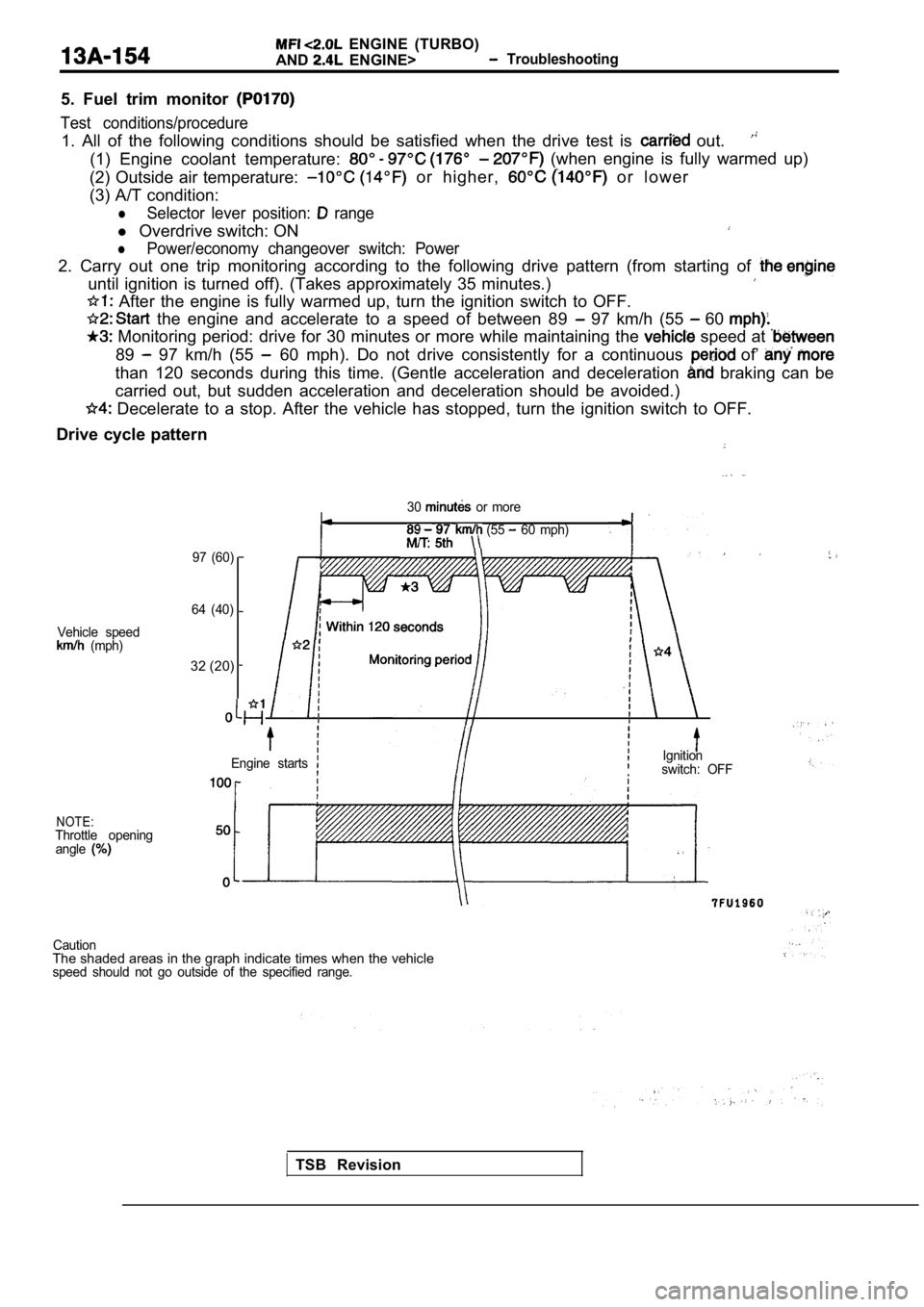
ENGINE (TURBO)
AND
ENGINE> Troubleshooting
5. Fuel trim monitor
Test conditions/procedure
1. All of the following conditions should be satisf ied when the drive test is out.
(1) Engine coolant temperature: (when engine is fully warmed up)
(2) Outside air temperature:
or higher, o r l o w e r
(3) A/T condition:
lSelector lever position: range
l Overdrive switch: ON
lPower/economy changeover switch: Power
2. Carry out one trip monitoring according to the f ollowing drive pattern (from starting of
until ignition is turned off). (Takes approximately 35 minutes.)
After the engine is fully warmed up, turn the igni tion switch to OFF.
the engine and accelerate to a speed of between 89 97 km/h (55 60
Monitoring period: drive for 30 minutes or more while maintaining the speed at
89 97 km/h (55 60 mph). Do not drive consistently for a continuous of’
than 120 seconds during this time. (Gentle acceleration and deceleration braking can be
carried out, but sudden acceleration and decelerati on should be avoided.)
Decelerate to a stop. After the vehicle has stopped, turn the ignition switch to OFF.
Drive cycle pattern
30 or more
(55 60 mph)
Vehicle speed
(mph)
NOTE:Throttle opening angle
97 (60)
64 (40)
32 (20)
Engine startsIgnitionswitch: OFF
CautionThe shaded areas in the graph indicate times when t he vehiclespeed should not go outside of the specified range.
TSB Revision
Page 535 of 2103
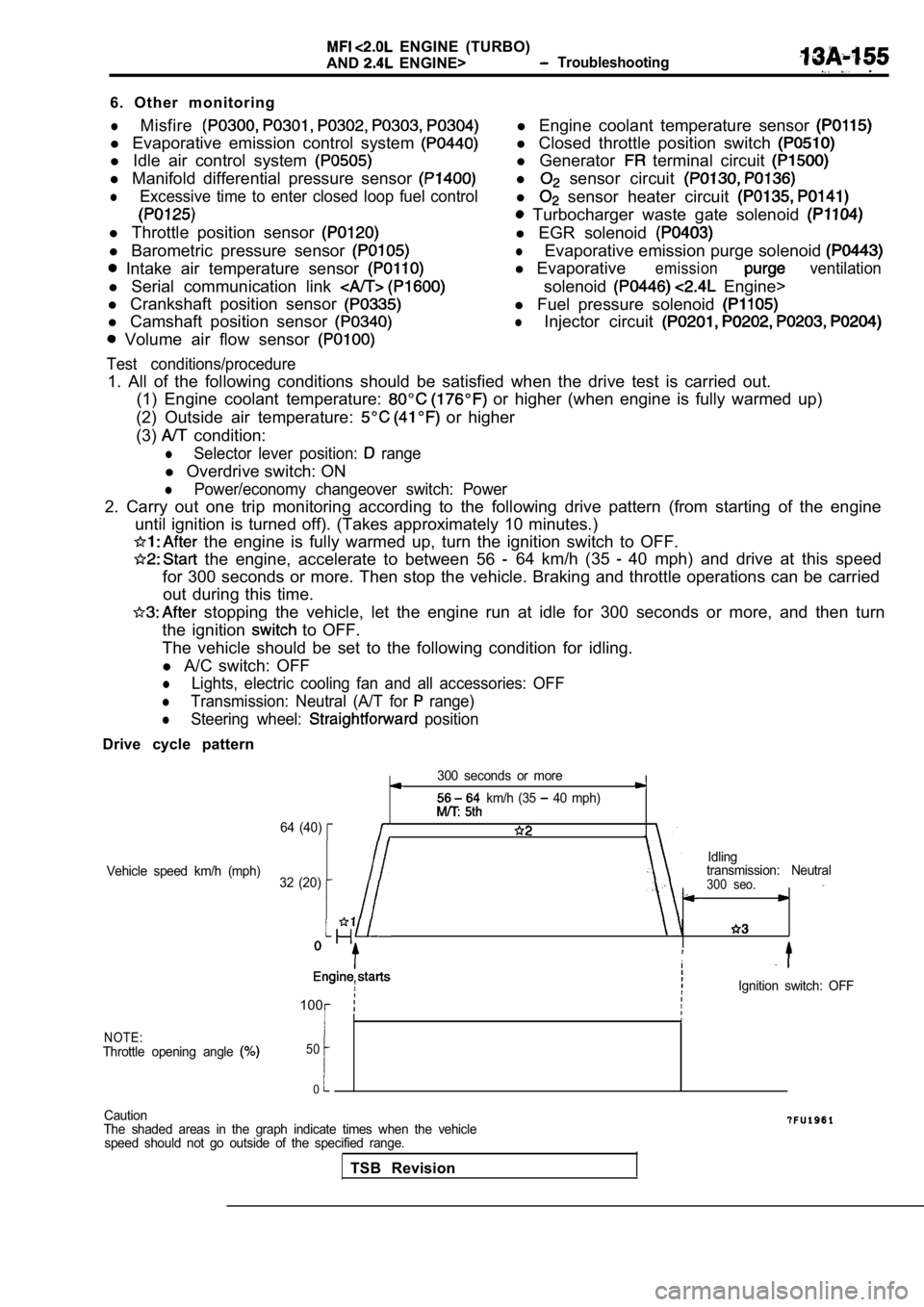
ENGINE (TURBO)
AND
ENGINE> Troubleshooting .
6. Other monitoring
lMisfire
l Evaporative emission control system
l Idle air control system
l Manifold differential pressure sensor
lExcessive time to enter closed loop fuel control
l Throttle position sensor
l Barometric pressure sensor
Intake air temperature sensor
l Serial communication link
l Crankshaft position sensor
l Camshaft position sensor
Volume air flow sensor
Test conditions/procedure
l Engine coolant temperature sensor
l Closed throttle position switch
l Generator terminal circuit
l sensor circuit
l sensor heater circuit
Turbocharger waste gate solenoid
l EGR solenoid
lEvaporative emission purge solenoid
l Evaporativeemissionventilation
solenoid Engine>
l Fuel pressure solenoid
lInjector circuit
1. All of the following conditions should be satisf ied when the drive test is carried out.
(1) Engine coolant temperature:
or higher (when engine is fully warmed up)
(2) Outside air temperature:
or higher
(3)
condition:
lSelector lever position: range
l Overdrive switch: ON
lPower/economy changeover switch: Power
2. Carry out one trip monitoring according to the f ollowing drive pattern (from starting of the engine
until ignition is turned off). (Takes approximately 10 minutes.)
the engine is fully warmed up, turn the ignition s witch to OFF.
the engine, accelerate to between 56 64 km/h (35 40 mph) and drive at this speed
for 300 seconds or more. Then stop the vehicle. Bra king and throttle operations can be carried
out during this time.
stopping the vehicle, let the engine run at idle f or 300 seconds or more, and then turn
the ignition
to OFF.
The vehicle should be set to the following conditio n for idling.
l A/C switch: OFF
lLights, electric cooling fan and all accessories: O FF
lTransmission: Neutral (A/T for range)
lSteering wheel: position
Drive cycle pattern
300 seconds or more
km/h (35 40 mph)
64 (40)
Idling
Vehicle speed km/h (mph) transmission: Neutral
32 (20)
300 seo.
,
Ignition switch: OFF
100
NOTE:Throttle opening angle 50
0
Caution
The shaded areas in the graph indicate times when t he vehicle
speed should not go outside of the specified range.
TSB Revision
Page 536 of 2103
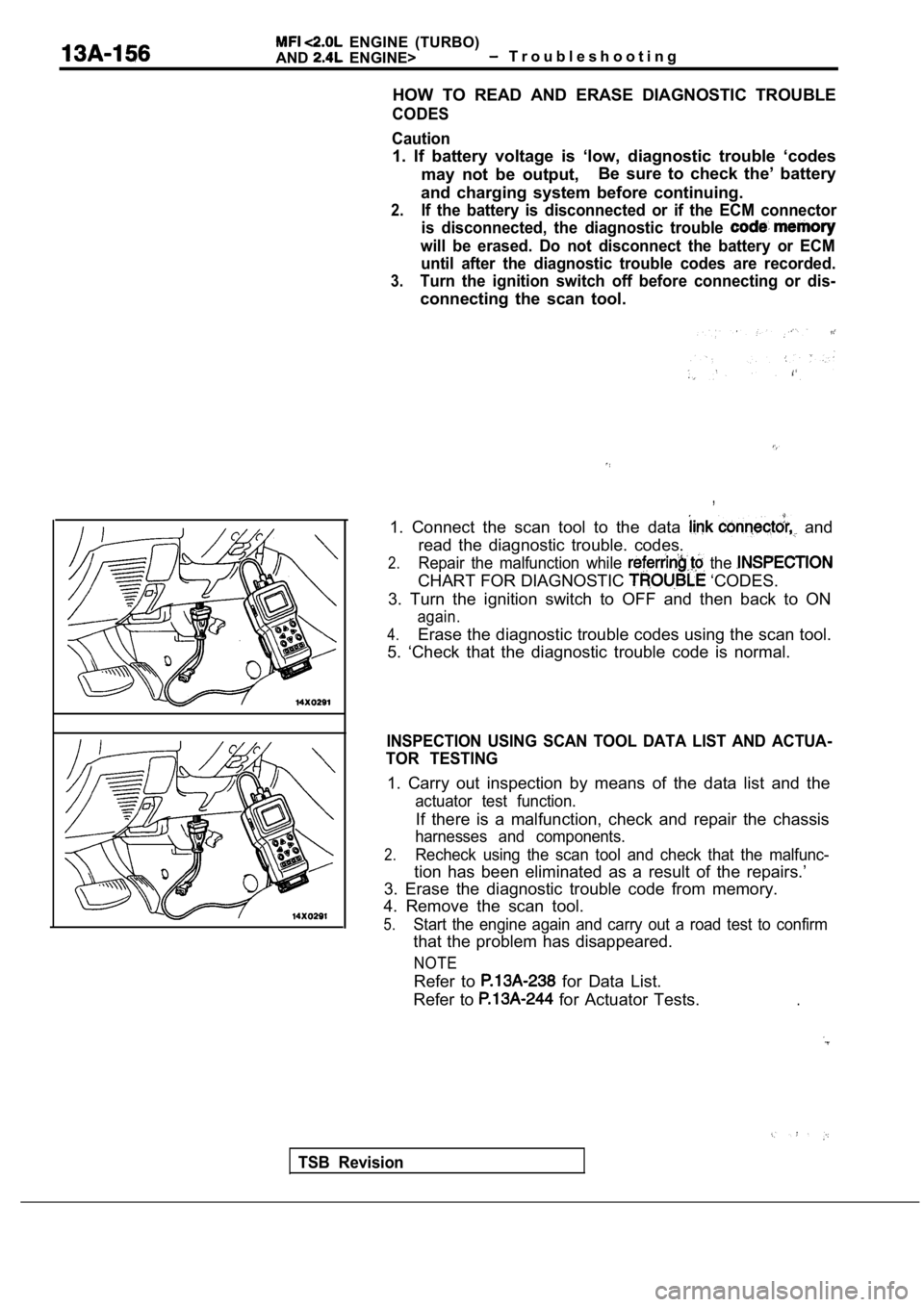
ENGINE (TURBO)
AND
ENGINE> T r o u b l e s h o o t i n g
HOW TO READ AND ERASE DIAGNOSTIC TROUBLE
CODES
Caution
1. If battery voltage is ‘low, diagnostic trouble ‘ codes
may not be output, Be sure to check the’ battery
and charging system before continuing.
2.If the battery is disconnected or if the ECM connec tor
is disconnected, the diagnostic trouble
will be erased. Do not disconnect the battery or EC M
until after the diagnostic trouble codes are record ed.
3.Turn the ignition switch off before connecting or d is-
connecting the scan tool.
,
1. Connect the scan tool to the data and
read the diagnostic trouble. codes.
2.Repair the malfunction while the
CHART FOR DIAGNOSTIC ‘CODES.
3. Turn the ignition switch to OFF and then back to ON
again.
4.Erase the diagnostic trouble codes using the scan tool.
5. ‘Check that the diagnostic trouble code is norma l.
INSPECTION USING SCAN TOOL DATA LIST AND ACTUA-
TOR TESTING
1. Carry out inspection by means of the data list a nd the
actuator test function.
If there is a malfunction, check and repair the chassis
harnesses and components.
2.Recheck using the scan tool and check that the malf unc-
tion has been eliminated as a result of the repairs.’
3. Erase the diagnostic trouble code from memory.
4. Remove the scan tool.
5.Start the engine again and carry out a road test to confirm
that the problem has disappeared.
NOTE
Refer to for Data List.
Refer to
for Actuator Tests..
TSB Revision
Page 537 of 2103
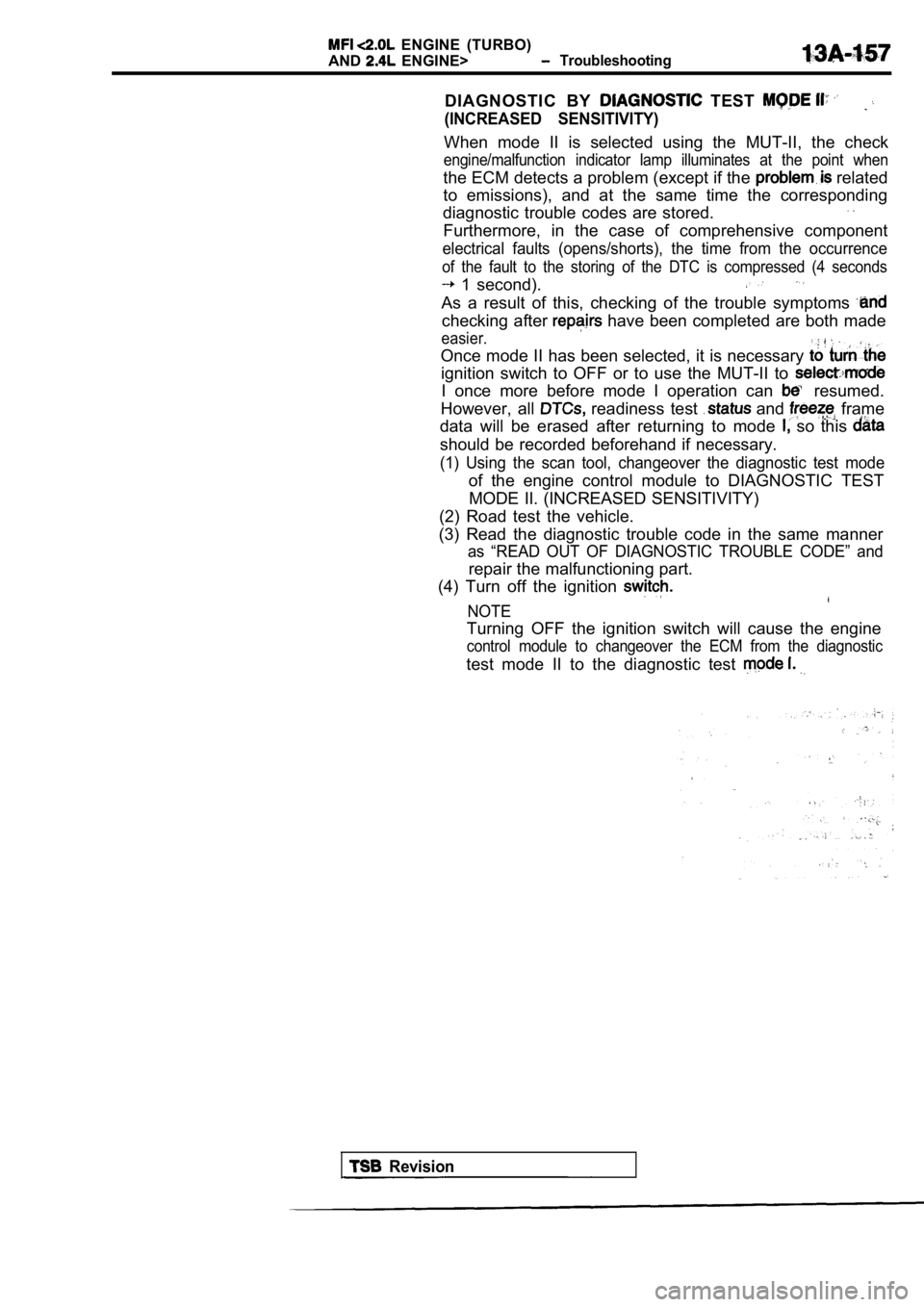
ENGINE (TURBO)
AND
ENGINE> Troubleshooting
DIAGNOSTIC BY TEST
(INCREASED SENSITIVITY)
When mode II is selected using the MUT-II, the chec k
engine/malfunction indicator lamp illuminates at the point when
the ECM detects a problem (except if the related
to emissions), and at the same time the correspondi ng
diagnostic trouble codes are stored.
Furthermore, in the case of comprehensive component
electrical faults (opens/shorts), the time from the occurrence
of the fault to the storing of the DTC is compresse d (4 seconds
1 second).
As a result of this, checking of the trouble symptoms
checking after have been completed are both made
easier.
Once mode II has been selected, it is necessary
ignition switch to OFF or to use the MUT-II to
I once more before mode I operation can resumed.
However, all
readiness test and frame
data will be erased after returning to mode
so this
should be recorded beforehand if necessary.
(1) Using the scan tool, changeover the diagnostic test mode
of the engine control module to DIAGNOSTIC TEST
MODE II. (INCREASED SENSITIVITY)
(2) Road test the vehicle.
(3) Read the diagnostic trouble code in the same ma nner
as “READ OUT OF DIAGNOSTIC TROUBLE CODE” and
repair the malfunctioning part.
(4) Turn off the ignition
NOTE
Turning OFF the ignition switch will cause the engi ne
control module to changeover the ECM from the diagn ostic
test mode II to the diagnostic test
Revision
Page 538 of 2103
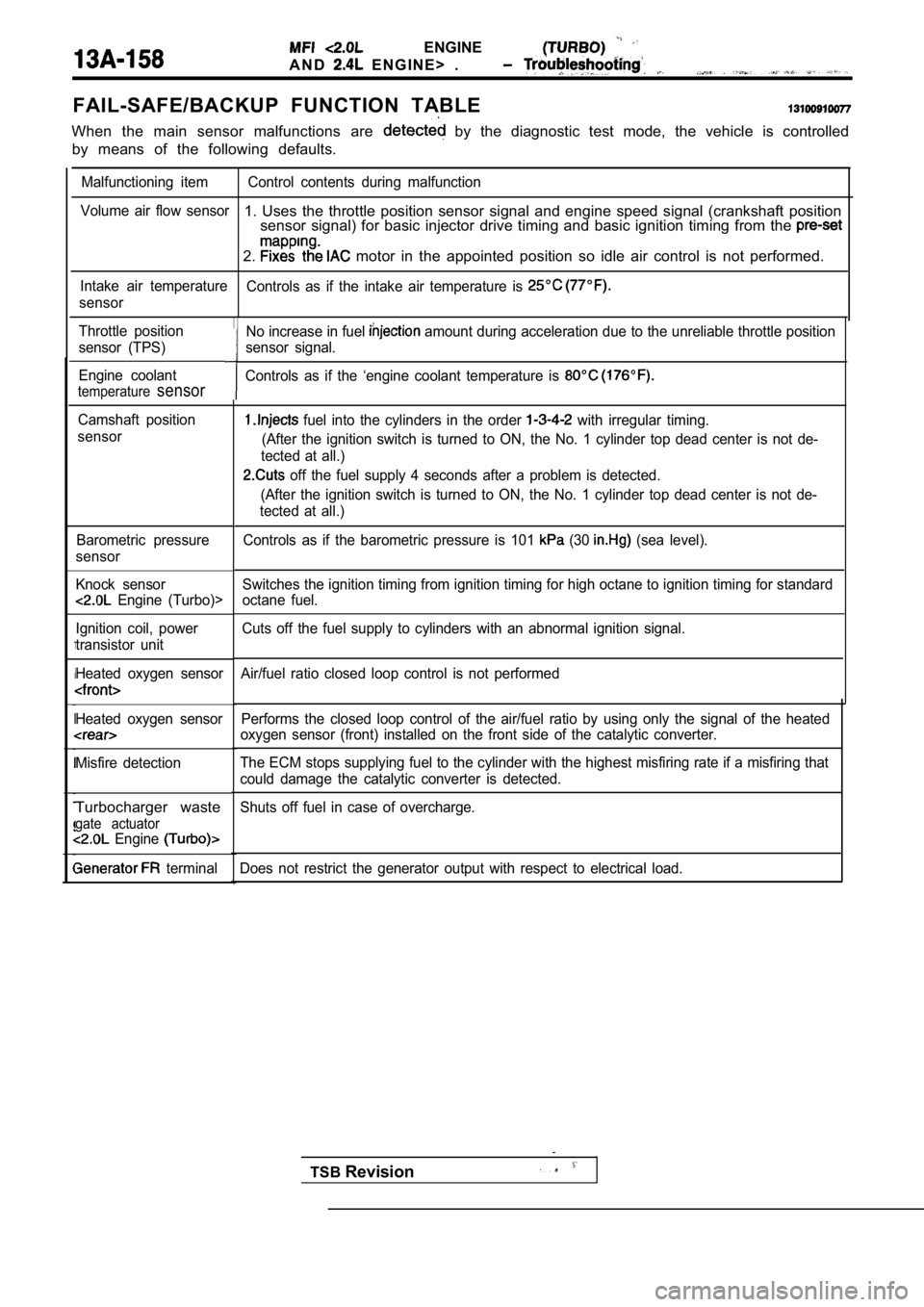
ENGINE
A N D E N G I N E > .
FAIL-SAFE/BACKUP FUNCTION TABLE
When the main sensor malfunctions are by the diagnostic test mode, the vehicle is controlled
by means of the following defaults.
Malfunctioning item Control contents during malfunct ion
Volume air flow sensor
1. Uses the throttle position sensor signal and eng ine speed signal (crankshaft position
sensor signal) for basic injector drive timing and basic ignition timing from the
2. motor in the appointed position so idle air contro l is not performed.
Intake air temperature
Controls as if the intake air temperature is
sensor
Throttle position
sensor (TPS)
Engine coolant
temperaturesensor
Camshaft position
sensor
Barometric pressure
sensor
Knock sensor
Engine (Turbo)>
Ignition coil, power
transistor unit
Heated oxygen sensor
Heated oxygen sensor
Misfire detection
Turbocharger waste
gate actuator Engine
terminal Performs the closed loop control of the air/fuel ra
tio by using only the signal of the heated
oxygen sensor (front) installed on the front side o f the catalytic converter.
The ECM stops supplying fuel to the cylinder with t he highest misfiring rate if a misfiring that
could damage the catalytic converter is detected.
Shuts off fuel in case of overcharge.
Does not restrict the generator output with respect to electrical load.
No increase in fuel amount during acceleration due to the unreliable throttle position
sensor signal.
Controls as if the ‘engine coolant temperature is
fuel into the cylinders in the order with irregular timing.
(After the ignition switch is turned to ON, the No. 1 cylinder top dead center is not de-
tected at all.)
off the fuel supply 4 seconds after a problem is d etected.
(After the ignition switch is turned to ON, the No. 1 cylinder top dead center is not de-
tected at all.)
Controls as if the barometric pressure is 101
(30 (sea level).
Switches the ignition timing from ignition timing f or high octane to ignition timing for standard
octane fuel.
Cuts off the fuel supply to cylinders with an abnor mal ignition signal.
Air/fuel ratio closed loop control is not performed
TSB Revision
Page 539 of 2103
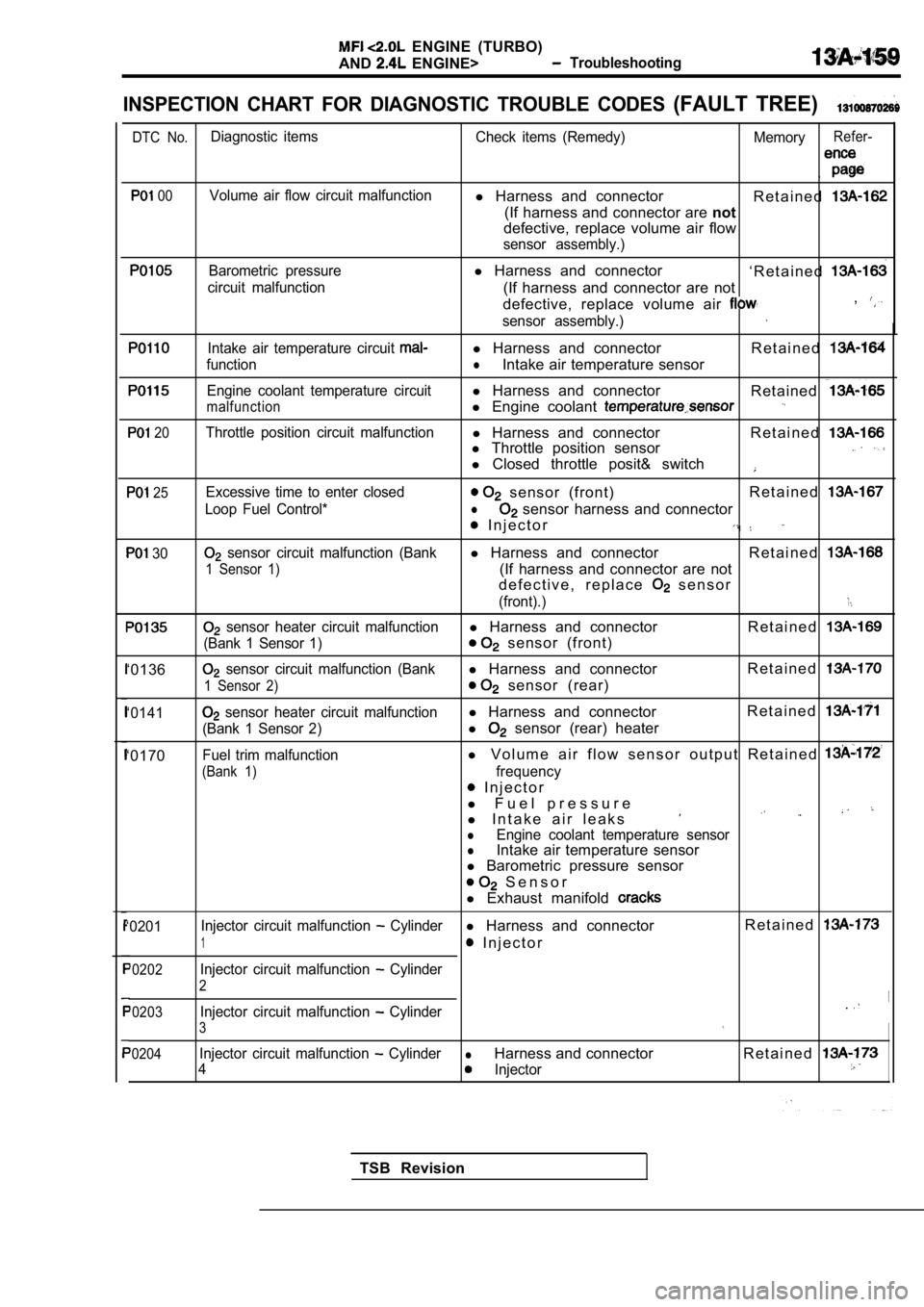
ENGINE (TURBO)
AND
ENGINE> Troubleshooting
INSPECTION CHART FOR DIAGNOSTIC TROUBLE CODES (FAULT TREE)
DTC No.Diagnostic items Check items (Remedy) MemoryRefer-
,
00Volume air flow circuit malfunctionl Harness and connector
R e t a i n e d
(If harness and connector are not
defective, replace volume air flow
sensor assembly.)
Barometric pressurel Harness and connector
‘ R e t a i n e d
circuit malfunction(If harness and connector are not
defective, replace volume air ,
sensor assembly.)
Intake air temperature circuit l Harness and connector R e t a i n e d
functionlIntake air temperature sensor
Engine coolant temperature circuitl Harness and connector
Retained
malfunctionl Engine coolant
20Throttle position circuit malfunctionl Harness and connector R e t a i n e dl Throttle position sensor
l Closed throttle posit& switch
25
30
‘0136
‘0141
‘0170
Excessive time to enter closed sensor (front) R e t a i n e d
Loop Fuel Control*l sensor harness and connector
I n j e c t o r
sensor circuit malfunction (Bankl
Harness and connector R e t a i n e d
1 Sensor 1)(If harness and connector are not
d e f e c t i v e , r e p l a c e
s e n s o r
(front).)
sensor heater circuit malfunctionl Harness and connector R e t a i n e d
(Bank 1 Sensor 1) sensor (front)
sensor circuit malfunction (Bankl Harness and connector R e t a i n e d
1 Sensor 2) sensor (rear)
sensor heater circuit malfunctionl
Harness and connector R e t a i n e d
(Bank 1 Sensor 2)l sensor (rear) heater
Fuel trim malfunctionl
V o l u m e a i r f l o w s e n s o r o u t p u t R e t a i n e d
(Bank 1)frequency
I n j e c t o r
l F u e l p r e s s u r e
l I n t a k e a i r l e a k s
lEngine coolant temperature sensorlIntake air temperature sensor
l Barometric pressure sensor
S e n s o r
l Exhaust manifold
‘0201 Injector circuit malfunction Cylinderl
Harness and connector R e t a i n e d
1 I n j e c t o r
‘0202Injector circuit malfunction Cylinder
2
‘0203Injector circuit malfunction Cylinder.
3
‘0204Injector circuit malfunction CylinderlHarness and connector R e t a i n e d
4Injector
TSB Revision
Page 540 of 2103
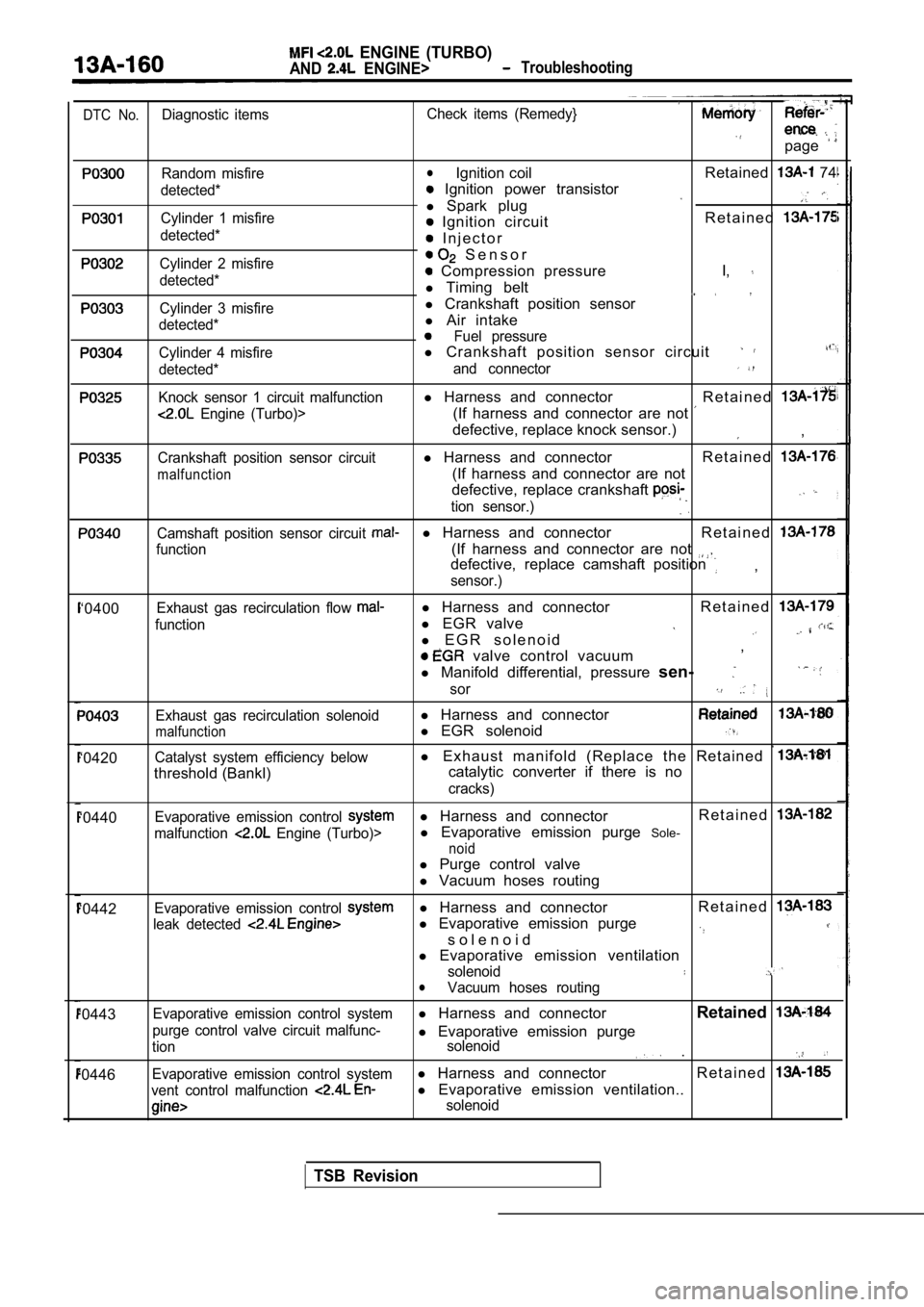
ENGINE (TURBO)
AND ENGINE> Troubleshooting
DTC No.Diagnostic itemsCheck items (Remedy}
page
Random misfire
detected*
Cylinder 1 misfire
detected*
Cylinder 2 misfire
detected*
Cylinder 3 misfire
detected*
Cylinder 4 misfire
detected*
Knock sensor 1 circuit malfunction
Engine (Turbo)>
Crankshaft position sensor circuit
malfunction
lIgnition coil Retained 74
Ignition power transistor
l Spark plug
R e t a i n e d Ignition circuit
I n j e c t o r
S e n s o r
Compression pressure I,
l
Timing belt
l Crankshaft position sensor
l Air intake
Fuel pressure
l Crankshaft position sensor circuit
and connector
l Harness and connector R e t a i n e d
(If harness and connector are not
defective, replace knock sensor.),
l Harness and connector R e t a i n e d
(If harness and connector are not
defective, replace crankshaft
tion sensor.)
Camshaft position sensor circuit l Harness and connector R e t a i n e d
function(If harness and connector are not defective, replace camshaft position
sensor.),
‘0400
‘0420
Exhaust gas recirculation flow
function
Exhaust gas recirculation solenoid
malfunction
Catalyst system efficiency below
threshold (Bankl) l
Harness and connector R e t a i n e d
l
EGR valve
l E G R s o l e n o i d
valve control vacuum ,
l Manifold differential, pressure sen-
sor
l Harness and connector
l EGR solenoid
l E x h a u s t m a n i f o l d ( R e p l a c e t h e R e t a i n e d
catalytic converter if there is no
cracks)
‘0440Evaporative emission control l Harness and connector R e t a i n e d
malfunction Engine (Turbo)>l
Evaporative emission purge Sole-
noid
l Purge control valve
l Vacuum hoses routing
‘0442
‘0443
‘0446
Evaporative emission control l Harness and connector R e t a i n e d
leak detected l
Evaporative emission purge
s o l e n o i d
l Evaporative emission ventilation
solenoidlVacuum hoses routing
Evaporative emission control system
l Harness and connector Retained
purge control valve circuit malfunc-l
Evaporative emission purgetion solenoid .
Evaporative emission control systeml
Harness and connector R e t a i n e d
vent control malfunction l
Evaporative emission ventilation..
solenoid
TSB Revision